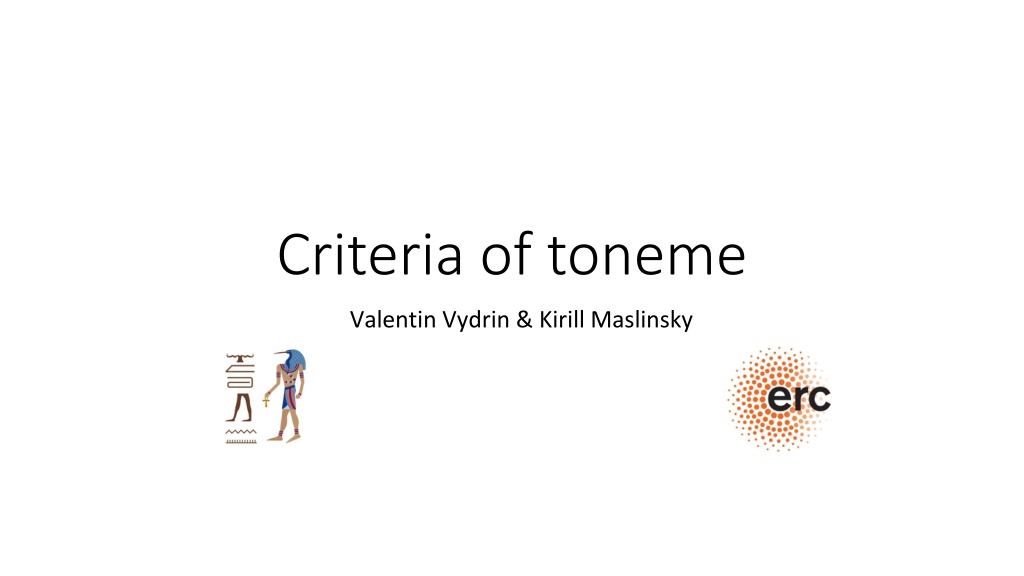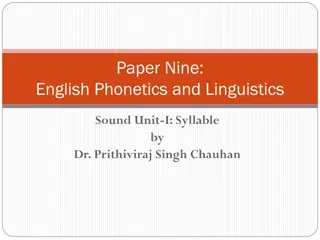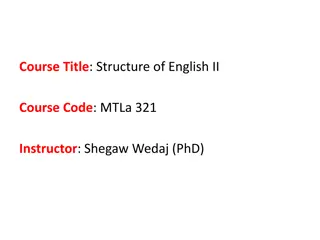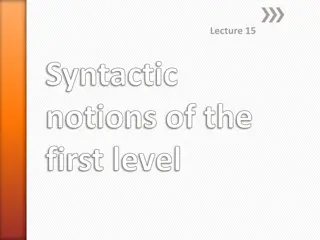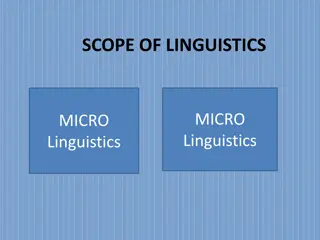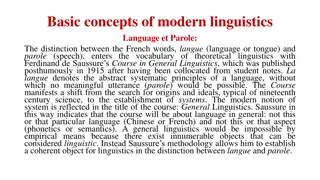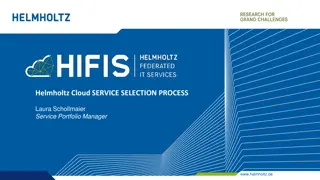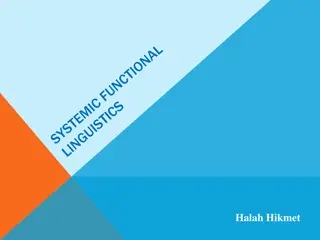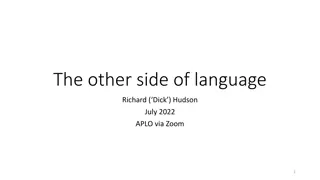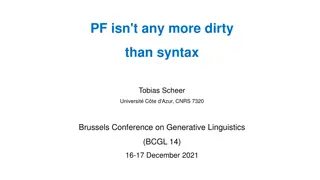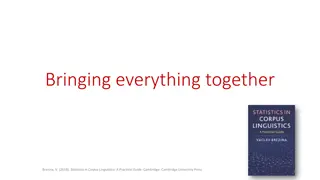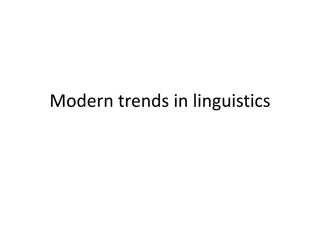Principles and Criteria of Toneme in Linguistics
Toneme, recognized as a key element in tonology, is defined as a meaningful tone that can differentiate lexical or grammatical meanings. The principles and criteria surrounding toneme status are systematically explored and proposed, emphasizing properties like sequentiality, continuity, scalability, and atomicity. Additionally, key tonemic processes are outlined, such as the One Toneme Per TBU Principle and TBU Occupancy Principle.
Download Presentation

Please find below an Image/Link to download the presentation.
The content on the website is provided AS IS for your information and personal use only. It may not be sold, licensed, or shared on other websites without obtaining consent from the author. Download presentation by click this link. If you encounter any issues during the download, it is possible that the publisher has removed the file from their server.
E N D
Presentation Transcript
Criteria of toneme Valentin Vydrin & Kirill Maslinsky
Toneme, a poor cousin of phoneme The basic unit of tonology. First used in 1920s by D.M.Beach: tones, in languages that contrastively employed them, are groupable into families called tonemes . Reinvented by Kenneth Pike (but his understanding of tone and toneme is obsolete by now). Often mentioned by tonologists, without clear specification. E.g., Collins dictionary definition of toneme: a phoneme that is distinguished from another phoneme only by its tone . We have tried to formulate some principles and criteria. A discussion is welcome. Our definition: Toneme is a meaningful tone, i.e. a tone which can (potentially) distinguish lexical and/or grammatical meanings. Toneme is the minimal constituitive unit of a tonal system. 2
Our objectives We aim to systematize the criteria for tonemic status that exist in literature, and propose our own. Our approach is axiomatic: to formulate general toneme properties and principles for tonemic processes so that the criteria of the tonemic status would follow from these properties and principles. The goal is to suggest a self-consistent model for the description of the tonal systems and tonal processes. 3
Toneme properties Sequentiality: tonemes follow each other, but do not overlap. Continuity: a toneme is realized on an uninterrupted sequence of TBUs. Scalability: a toneme can be realized on one or more than one TBU. Atomicity: in any given context, a toneme is a part of the exponent of only one morpheme. A comment: The latter property does not mean that the segment on which a toneme is realized cannot be subdivided into morphemes. 4
Principles for tonal processes The One Toneme Per TBU Principle - The TBU Occupancy principle - The Toneme Deletion Principle - The Screening Principle 5
The One Toneme Per TBU Principle The One Toneme Per TBU Principle One TBU cannot bear more than one toneme if no tonal process is involved. In other words, on the underlying level only one toneme can be linked to a TBU. If more than one toneme is realized on a same TBU on the surface level, it is always the result of some tonal process. 6
The TBU The TBU Occupancy Occupancy Principle Principle If a TBU is involved in a tonemic contrast, it is involved in it completely. In other words, a TBU cannot be shared between a toneme and a zero. A TBU can bear 0, T, T+T, but not *T+0. 7
The Toneme Deletion Principle The Toneme Deletion Principle A toneme deletion can be conditioned either by another toneme, or by the configuration of a segmental chain, or by a substractive tonal morpheme, but not by a zero tone. Examples of configuration-conditioned deletion of tonemes: - in Haya (Bantu), the H of the utterance-initial vowel is lost entirely (Hyman 2000: 15); - in Hausa (Chadic), a LHL melody on the Group 2 verbs is shortened to LH if the verbal stem is disyllabic (rather than trisyllabic); About the substractive tonal morpheme, see The Tonal Morpheme Criterion below. 8
The Screening Principle The Screening Principle Realization of tonemes (= a tonal processes concerning a toneme) can be conditioned only by the preceding or the following toneme in a segmental chain. That is, an adjacent toneme screens the influence of further remote tonemes. If realization of a toneme depends somehow on the availability of a toneme in a non-adjacent TBU, then the TBU(s) separating these tonemes bear(s) no tonemes (i.e., their tone has no tonemic status, it is ). 9
The Screening Principle, The Screening Principle, cont. This principle is a reformulation of Hyman s (2000) idea: if the opposition is /H, L/, H tones should not be expected to interact with each other across L s. If the opposition is /H, /, on the other hand, the H s on each side of a toneless TBU should be able to see each other even across long distances. 10
Criteria for tonemic status General criteria Criteria for contour tonemes Criteria for privative tonemic oppostion (non-zeroeness) 11
Two general criteria for the tonemic status The Persistence Criterion The Persistence Criterion The Extensibility Criterion The Extensibility Criterion 12
The Persistence Criterion The Persistence Criterion If a tone is contrastive and it persists in all contexts (i.e., it is not affected by tonal processes which could be regarded as criteria of tonemic status), such tone is considered to be a toneme. This criterion may be sufficient for simple tonal systems where tones are stable and no (or very few) tonal processes are attested. Based on The One Toneme Per TBU Principle 13
The Extensibility Criterion If a tonal melody can be mapped onto a segmental unit (most often, word) represented by a single TBU, but can also be hosted by a longer unit, this melody is a toneme. This criterion is based on the Scalabitlity Property and One Toneme per TBU Principle. This criterion is meant to answer a question: if a language has steady tonal melodies, what is their status? Are they tonemes or combinations of tonemes? According to the Extensibility Criterion, the answer depends on the ability of the melody to be mapped onto one TBU. 14
The Extensibility Criterion, cont. Examples of languages where extensible melodies can be hosted by one TBU and are therefore recognized as tonemes: Mende, Bambara, Lhasa Tibetan. In Hausa, there are several steady extensible melodies, but they cannot be mapped on one TBU (a mora), therefore they are not tonemes. In the languages with extensible tonemes, the principle of congruence of tonal spans with words is not necessarily absolute. E.g., in Bambara, about 90% of words coincide with tonal spans, but there are also some words which host more than one tonal span; on the other hand, a tonal span can extend over the limits of one word. And still, the interpretation of the tonal system in the terms of tonal curves as single tonemes with extensible tonal spans remains coherent. 15
Two criteria for a contour toneme The Non-Compositionality Criterion The Single TBU criterion 16
The Non-Compositionality Criterion If a language has a tonal contour realized on one TBU composed of levels which are not available in this language as tonemes, this contour is a toneme. This criterion was widely used by Pike (1948); see also (Yip 2002, 50). 17
The Single TBU criterion If a tonal contour can appear on one TBU as an element of an exponent of a single morpheme, and the contour is not a result of a tonal process (such as tonal spread, etc.), this contour is a toneme. This criterion is a consequence of The One Toneme Per TBU Principle and The Atomicity Property of toneme. Among the questions to be answered: both situations may coexist in a language (e.g. on some single syllables, a LH tone is a result of tonal processes, while in some other cases, LH is a single lexical contour). If we accept the Toneme Atomicity, we should posit that in the latter case, we have one contour toneme, and in the former, a combination of two level tonemes. 18
The Copy/Spread Criterion (Yip 2002: 51) ? If a contour can be copied or spread on a unit, it is a toneme (otherwise, if the contour is composed of level tonemes, it is the final level toneme that is copied or spread). The instances of its applicability seem to be rare, e.g. Lalana Chinantec, Changzhi, Danyang Chinese. To be rejected: - it clashes with the Extensibility criterion; - it does not distinguish between the tone copy and tone spread; - cases can be found where non-monotonemic contours are copied (in particular, in reduplication). 19
Yips vowel deletion criterion? (Yip 2002, 47) Hausa: mi ni = mi n to me , therefore, F = HL ( two level tones ). It is true that in Hausa, F = HL (two tonemes). To be rejected: it contradicts The Extensibility Criterion. 20
Criteria for non-zeroness The The Floating Criterion Floating Criterion The Tonal Morpheme Criterion The Tonal Morpheme Criterion The Shared TBU Criterion The Shared TBU Criterion The Activity Criterion The Activity Criterion 21
The The Floating Criterion Floating Criterion If a tone can float, it is a toneme. (an alternative formulation : A zero tone cannot float.) This criterion was suggested by Hyman (2000): Only specified tones can float . 22
The Tonal Morpheme Criterion The Tonal Morpheme Criterion An additive or replacive tonal (non-segmental) morpheme contains at least one toneme. Can there be tonal morphemes containing tones? (our presupposition: a zero tone cannot be a part of tonal morpheme) A grammatically conditioned deletion of tonemes in a privative system can be interpreted as a substractive tonal morpheme. To postulate a substractive tonal morpheme, we need evidence for its morphemic status (to avoid referring to any tonal process as a morpheme). 23
The Shared TBU Criterion The Shared TBU Criterion If two level tones can be assigned to one TBU, both tones are tonemes (unless this contour is a toneme, see creteria for the contour tonemes above) , and neither is . This criterion is based on the TBU Occupancy Principle. It was discussed by Hyman (2000) at length ( it should not be possible to have HL or LH contour tones in a language in which the opposition is /H/ vs. / / ). 24
The Activity Criterion The Activity Criterion If a tone appears as a part of condition in a tonal rule, it is a toneme. Formulated by Hyman (2000: 5) as follows: If the opposition is /H, /, tone rules should refer only to H s. The most current rules (which can be regarded as diagnostical): - tone spread; - tone shift / displacement; - plateauing; - reduction / assimilation. 25
The Constraints Criterion by Hyman Hyman (2000) suggests a distribution criterion for detecting an active tone. This criterion is formulated as follows: There are constraints on the marked tone occurring, and there are no constraints on occurring. We reformulate it as follows: If there are positional constraints for a tone relative to some segmental unit, this tone is a toneme. This formulation makes the criterion more operational. 26
Criteria for tonemic status General criteria - The Persistence Criterion - The Extensibility Criterion Criteria for countour tonemes - The Non-Compositionality crit. - The Single TBU criterion Summary Toneme properties Toneme properties - sequentiality - continuity - sclability - atomicity Criteria for non-zeroness - The Floating Criterion - The Tonal Morpheme Criterion - The Shared TBU Criterion - The Activity Criterion - The Constraints Criterion Principles for tonemic processes - The one toneme per TBU - The TBU Occupancy principle - The deletion principle - The screening principle 27
